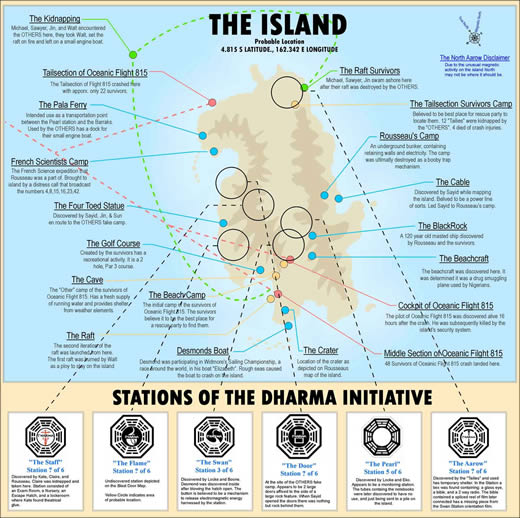Sonic Bloom: a thesis in four acts (TV series: LOST)
By Chiu Longina • Mar 9th, 2008 • Category: TEXTO
http://www.losttv-forum.com/forum/showthread.php?t=296&highlight=sound+island
“Remember sucking wind and noise – deafening noise. Head still ringing.”
Danielle in “Solitary”:
“I remember the terrible sound”
Imagine a deafening noise capable of guiding a plane to a safe landing, the French castaways to shore, Locke to his boar.
Imagine a technology so clean, so natural, so transparent that it leaves no trace behind.
Imagine the sound.
The sound within
Imagine descending into an Alice-in-Wonderland canyon where the echo that returns when you shout “hello” sounds like “olleh.” No such sound-reversal canyons exist in nature. However, physicists in Europe and the United States have recently been creating environments in the laboratory and underwater that exhibit reversed echoing. …
Such setups refocus sound with remarkable precision. When a person sings out “hello” in such an environment, the sound not only comes back reversed but it also beams specifically to the vocalist’s head, and nowhere else.
These traits make time-reversed acoustics, as this technology is known, promising for a wide range of uses, including … broadcasting different translations of a speaker to listeners sitting side by side.
Many environments bend and bounce signals around so much that they become severely distorted. … [But] an environment with many sound-bending and sound-reflecting obstacles actually improves a time-reversal mirror’s projection of sounds back to a specific location. The more reflecting surfaces there are in the environment, the wider the spatial spread of the components of sound the mirror gathers. And that provides the mirror with more precise guidance for targeting the echo.
Mathias Fink of the University of Denis Diderot in Paris, France and some other scientists also expect that the same techniques may work in the electromagnetic realm, perhaps increasing the signal-carrying capability of wireless communication systems…
Getting more practical, scientists are considering such uses as auditorium systems that could simultaneously transmit completely different sound streams to people sitting right next to each other. This concept could be applied, for example, at the United Nations, where speeches must be simultaneously translated into many languages for different listeners. Instead of donning headphones, however, the UN delegates would simply hear the appropriate translation where they sit.
Similarly, family members traveling in a car might simultaneously listen to different radio stations.
Reversed echoes may fight disease and foster communication
The sound that heals
For many years, scientists have been investigating the use of inaudible, high-intensity ultrasound for incision-free surgery but the hodgepodge of tissues in the human body distorts acoustic signals, making it difficult to precisely aim the acoustic energy.
That’s where time-reversal mirrors can come in. For more than a decade, Fink’s group has been developing versions of ultrasonic devices, known as lithotripters, for destroying mineral stones that can form in the kidney and gall bladder. First, the lithotripter’s time-reversal mirror broadcasts unfocused sound into an organ to create reflections that reveal a stone’s location. Then, the device sends a time-reversed form of the reflections, but greatly amplified, to shatter the target.
…. Emad S. Ebbini and his colleagues at the University of Minnesota in Minneapolis are also showing how such mirrors might be applied in medicine. They are investigating time-reversed ultrasound for two procedures: knocking out heart tissue that misfires electrically and destroying tumors.
Time-Reverse Acoustic Research Promises Medical Breakthrough
The sound that searches
Another acoustically noisy environment where time-reversal methods are drawing attention is the ocean. … William A. Kuperman of Scripps Institution of Oceanography in La Jolla became interested in time-reversed acoustics in the mid-1990s while working on a Navy-funded ocean-modeling project. His challenge was to devise computer models of ocean acoustics that would make it possible to take signals received at underwater listening posts and trace them back to their sources, for instance, enemy submarines. The advantage of doing it all on computers, he notes, is that no sonar pings are generated, so there would be nothing to tip off a target that it’s being stalked.
The test results have been “spectacular,” Kuperman says. “Time reversal is undoing the complexity of the ocean.” From a distance of 10 kilometers, for example, the team refocused a sound pulse into a spot only a few meters in depth. … Now that Kuperman and his colleagues have established how well ocean-based time reversal can work, they’re investigating how to exploit time-reversed acoustics for detecting submarines and mines, developing a better understanding of the ocean environment, and communicating between undersea vehicles.
One of the nifty features of this communication scheme is that the information is covert, Kuperman says. “Off the focus, you get [only] rumbling.”
TRM in Ocean Acoustics
Applications of TR to Underwater Acoustics
The sound that burns
Thermoacoustics (TA) is the study of the conversion of acoustic energy – compression waves in a gas (sound) – into heat energy and vice versa. Acoustic energy can be harnessed in sealed systems and used to create powerful heat engines, heat pumps, and refrigerators.Thermoacoustic devices use these compression waves*to replace mechanical pistons, crankshafts, and valves, reducing the number of moving parts in their design and making them simple, reliable machines. Thermoacoustic cryocoolers generally have two major sections to their design: an electroacoustic transducer (like a loudspeaker) and a coldhead.

Chiu Longina is
Email this author | All posts by Chiu Longina




